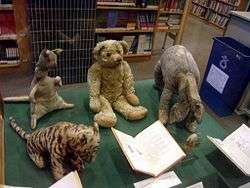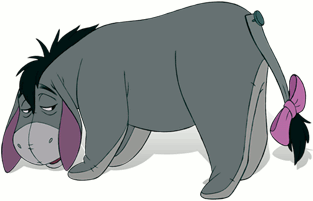Eeyore
| Eeyore | |
|---|---|
| 'Winnie-the-Pooh' character | |
| First appearance | Winnie-the-Pooh (1926) |
| Created by | A. A. Milne |
| Information | |
| Species | Donkey |
| Gender | Male |

Eeyore (![]() i/ˈiːɔːr/ EE-or) is a character in the Winnie-the-Pooh books by A. A. Milne. He is generally characterized as a pessimistic, gloomy, depressed, anhedonic, old grey stuffed donkey who is a friend of the title character, Winnie-the-Pooh.
i/ˈiːɔːr/ EE-or) is a character in the Winnie-the-Pooh books by A. A. Milne. He is generally characterized as a pessimistic, gloomy, depressed, anhedonic, old grey stuffed donkey who is a friend of the title character, Winnie-the-Pooh.
In the books
Eeyore appears in chapters IV, VI, VII, and X of Winnie-the-Pooh, and is mentioned in a few others. He also appears in all the chapters of The House at Pooh Corner except chapter VII. His name is an onomatopoeic representation of the braying sound made by a normal donkey, usually represented as "hee haw" in American English: the spelling with an "r" is explained by the fact that Milne and most of his intended audience spoke a non-rhotic variety of English in which the "r" in "Eeyore" is not pronounced as /r/.[1][2]
Physically, Eeyore is described as an "old grey donkey." In Ernest H. Shepard's illustrations, he appears to be about chin-high to Pooh and about hip-high to Christopher Robin. He has a long, detachable tail with a pink bow on the end, of which he is very fond, but which he is also prone to losing (Owl once mistakes it for a bell-pull). Christopher Robin is able to reattach the tail with a drawing pin.
In The House at Pooh Corner, Eeyore's level of literacy is unclear. When Christopher Robin shows him the letter "A," Eeyore does not understand its meaning, knowing only that "it means learning," something he desperately wants to be seen as having, but he angrily destroys the letter after finding that Rabbit (who is quite literate) knows about it already. Nevertheless, he spells his own name "eoR" when signing the "rissolution" that the animals give to Christopher Robin as a farewell present in the final chapter. Eeyore also wrote the awkwardly-rhymed poem called "POEM", which appeared on the "rissolution", making him the only character in the Winnie-the-Pooh books other than Pooh himself who attempts to write poetry (a fact that Eeyore himself notes). When Pooh humbly declares that Eeyore's poetry is better than his own, "really believing it to be true," Eeyore vainly replies that "it was meant to be."
Eeyore has a poor opinion of most of the other animals in the Forest, describing them as having "No brain at all, some of them", "only grey fluff that's blown into their heads by mistake" (from chapter 1 of The House at Pooh Corner). Eeyore's favorite food is thistles. He lives in the southeast corner of the Hundred Acre Wood, in an area labeled "Eeyore's Gloomy Place: Rather Boggy and Sad" on the map in the book. He has a stick house therein called The House at Pooh Corner. Pooh and Piglet built it for him after accidentally mistaking the original house that Eeyore built for a pile of sticks. On Eeyore's birthday, he is given an empty honey jar from Pooh for keeping things in, a popped red balloon from Piglet to keep in the pot, and a note from Owl.
Eeyore is also surprisingly good at the game Poohsticks, winning more times than anyone else when it is played in the sixth chapter.
Disney adaptations
| Eeyore (Disney version) | |
|---|---|
 | |
| First appearance | Winnie the Pooh and the Honey Tree (February 4, 1966) |
| Created by | A.A. Milne |
| Voiced by |
Ralph Wright (1966-1983) Ron Feinberg (1981) Ron Gans (1983-1986) Peter Cullen (1988-2010) Bud Luckey (2011-present) Gregg Berger (Kingdom Hearts II) |
| Information | |
| Species | Donkey |
| Gender | Male |
Eeyore appears in the Winnie the Pooh cartoons popularized by The Walt Disney Company. He is somewhat less caustic and sarcastic in the Disney version than in Alan Milne's original stories. Though often a supporting character, Winnie the Pooh and a Day for Eeyore focuses on him. He is physically one of the stronger animals and is often treated as a pack animal whenever a plot calls for one. His house is regularly knocked down, but he always rebuilds it. He usually expects misfortune to happen to him, accepts it when it does and rarely even tries to prevent it. His catchphrases are "Thanks for noticin' me" and "Ohhh-kayyy".
Despite his depressive nature, Eeyore is capable of great compassion, whereas in the books he is more apathetic. Several episodes of The New Adventures of Winnie the Pooh episodes exemplify this, including "Donkey for a Day", "Stripes", "Home is Where the Home is" and "Eeyi Eeyi Eeyore". Eeyore is usually one of the core group of animals, along with Pooh, Piglet, Rabbit and Tigger. Of these five, he is the most reluctant to go along with their plans or adventures, but does not oppose them because he believes it to be futile to try.
In the adaptations, Eeyore has developed a close friendship with Tigger. Despite their opposite personalities, Eeyore's passive nature and Tigger's optimism and outgoingness help them to accept each other's flaws and understand each other better. Their closeness begins at the end of Winnie the Pooh and a Day for Eeyore and continues in later works such as The New Adventures of Winnie the Pooh, A Winnie the Pooh Thanksgiving and the Winnie the Pooh film.
His tail was not always fixed to him by a nail, although Disney has chosen this as part of his permanent image. When Eeyore lost his tail, Owl found it and used it as a bell-pull beside his door before Pooh found it for Eeyore. Christopher Robin then pinned it back on. According to Winnie the Pooh and the Honey Tree, this was possible because Eeyore is full of sawdust. In Disney merchandise, Eeyore sometimes has an uncharacteristic smile. In animation, Eeyore is colored his natural grey, though he is coloured blue with a pink muzzle in merchandising. He appears at the Walt Disney Parks and Resorts for meet and greets.
Casting history
Eeyore was voiced by Ralph Wright in the original featurettes, although Ron Feinberg filled in as his voice in the short film Winnie the Pooh Discovers the Seasons. Ron Gans took over the role for Welcome to Pooh Corner and was succeeded by Peter Cullen in The New Adventures of Winnie the Pooh through My Friends Tigger and Pooh. Although Cullen was still active when the film Winnie the Pooh was in production, Eeyore was voiced by Bud Luckey for the film. In reference to this, Cullen re-enacted a scene at BotCon to demonstrate a scene where his character Optimus Prime meets Eeyore. Gregg Berger voiced Eeyore in the Kingdom Hearts series and Kinect Disneyland Adventures.
See also
References
- ↑ Pyles, Thomas. The Origins and Development of the English Language. 2nd Edition. Harcourt Brace Jovanovich; New York. (1971).
- ↑ Observations on British and American English by an American linguist in the UK
External links
- Eeyore at the Internet Movie Database